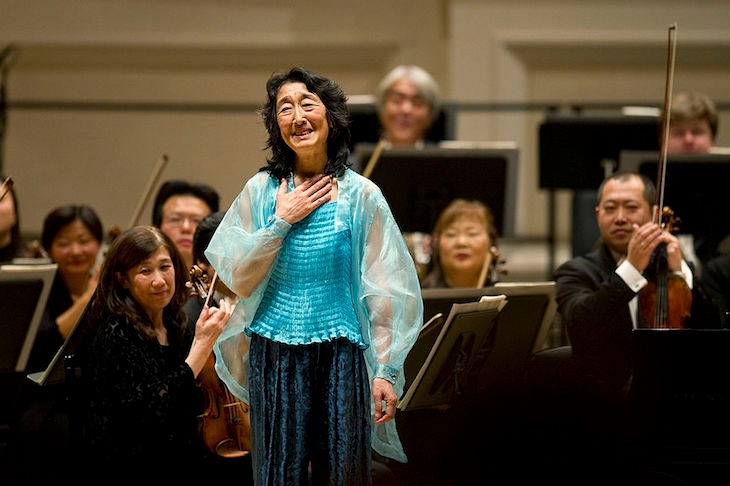Debussy’s Prélude à l’après-midi d’un faune begins with a sigh: a long, languorous exhalation played on the lower notes of a solo flute. The flute’s usual brightness and brilliance is gone. It’s a dusky, breathy sound, made of half-shades and velvet: the musical embodiment of luxe, calme et volupté. And it’s completely impossible to imitate on a piano. Not so much because of the tone-colour — the best pianists can create wonders — but because no piano in existence can play an unbroken melody. Wind and string players, like singers, produce and control a near-continuous stream of sound. A piano, though, is essentially a box of hammers. It hits notes, and then they decay. When a pianist seems to play a long, singing tune, they’re merely faking at a very high level. It’s a sonic trompe l’oeil.
Benjamin Grosvenor solved the problem by dismissing it. Confronted with those opening bars, he made no attempt to imitate the sound or phrasing of a flute. Instead, they became a tiny prelude-to-the-Prélude, a preliminary running of the fingers over the keys. It was a strange transformation, and the first of many. The rippling harp figures that make Debussy’s orchestra quiver and pulse from within became sudden, glittering sprays of sound, high above the musical landscape. And Debussy’s climaxes, played as cascades of rich piano chords, inescapably suggested a peal of bells — an image that exists neither in Debussy’s original, nor the poem by Mallarmé that inspired it. Well, if you’re going to reinvent something, reinvent it thoroughly. Grosvenor played it with the glowing intensity and spacious, aristocratic assurance that he brought to this whole recital.
But why bother with a piano transcription of the Prélude at all? It’s not like there’s any shortage of original Debussy piano music. One possible answer came in the next item on the programme, Alban Berg’s tortuous, determinedly moody Piano Sonata Op.1. Grosvenor found a shadowy sonority for its opening gestures that seemed to relate directly to the ending of the Debussy. Anyone who’s followed Grosvenor’s career so far knows that he’s an artist of unusual intelligence, and it’s still a relatively rarepianist who thinks about recital programmes in these terms, let alone steps beyond theroutine piano repertoire to place a work like the Berg in such an ear-opening context.
Earlier, he’d created another unexpected narrative by interleaving the three movements of Brett Dean’s Etude: Hommage à Brahms of 2013 between the four short pieces that make up Brahms’s Op.119 — as Dean intended, but as Brahms certainly didn’t. The effect was curious and sometimes disturbing. Dean’s outer movements, entitled ‘Angel’s Wings’, fix ghostly fragments of Brahms’s pieces in strange positions and hold them up to the light, like the scuffled impressions left on a window pane after a small bird has collided with the glass. The central ‘Hafenkneipenmusik’ is a demonic moto perpetuo, an act of musical cruelty in the midst of Brahms’s quiet, hard-won melancholy that left me wondering — as I did during Dean’s recent opera Hamlet —whether this skilled composer isn’t himself trapped within a musical language that can only express infinite shades of angst.
Still, presumably it was part of Dean’s plan that Brahms’s fourth and final piece, a Rhapsodie, should break free from his grip with such triumphant power. Grosvenor’s performance was radiant, sonorous and proud, though here, too, as throughout the entire programme (and even in his final, blistering performance of Ravel’s Scarbo), he felt like an artist whose intellect was restraining rather than liberating his magnificent technique. I want to be there when Grosvenor finally gets head and heart into perfect alignment.
We know it can be done, because a couple of days earlier, at Birmingham Town Hall, Mitsuko Uchida did it. Like Grosvenor, Uchida cuts a restrained figure at the keyboard, and her performances, too, are shaped by intellect as well as fantasy. Apollo, not Dionysus, reigns here. But over three Schubert sonatas she found limitless opportunities for colour and characterisation within formal structures that were as lucid and as ideally proportioned as Schubert’s ramshackle classicism allowed. And all the time she was pushing enthusiastically forwards into phrases, playfully answering her own statements, and giving a droll, throwaway swing to Schubert’s little bass asides.
I’d gone into this concert with preconceptions: Uchida’s long career and her status as international piano royalty (she uses publicity photos by Richard Avedon) made the freshness of her playing a genuine surprise. If you’d attended both concerts blindfold, you’d have said that Uchida was the headstrong twentysomething and Grosvenor the veteran. But clarity needn’t exclude mystery, and wisdom can go along with quite irresistible wit. I was reminded of the pianist-composer Ferruccio Busoni’s aphorism on Mozart: ‘He commands both light and shade: but his light never blinds, and his darkness still shows definite outlines.’






Comments